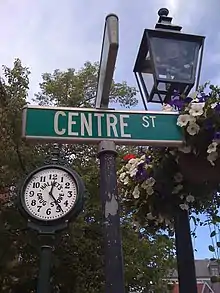Seth Thomas | |
|---|---|
.jpg.webp) | |
| Born | August 19, 1785 Wolcott, Connecticut, United States |
| Died | January 29, 1859 (aged 73) Thomaston, Connecticut, United States |
| Resting place | Hillside Cemetery, Thomaston |
| Children | 9 |
| Engineering career | |
| Projects | Clock at Grand Central Terminal |
| Significant advance | Clockmaker and a pioneer of mass production |
Seth Thomas (1785 — 1859) was an American clockmaker and a pioneer of mass production at his Seth Thomas Clock Company.
Biography
Thomas was born in Wolcott, Connecticut, in 1785. He was apprenticed as a carpenter and joiner, and worked building houses and barns. He started in the clock business in 1807, working for clockmaker Eli Terry.[1] Thomas formed a clock-making partnership in Plymouth, Connecticut, with Eli Terry and Silas Hoadley as Terry, Thomas & Hoadley.[1]
In 1810, he bought Terry's clock business, making tall clocks with wooden movements, though he chose to sell his partnership in 1812, moving in 1813 to Plymouth Hollow, Connecticut, where he set up a factory to make metal-movement clocks. In 1817, he added shelf and mantel clocks. By the mid-1840s, he changed over to brass from wooden movements. He made the clock that is used in Fireman's Hall. He died in 1859, whereupon the company was taken over by his son, Aaron, who added many styles and improvements after his father's death. The company went out of business in 2009.
Death and legacy
Thomas died on January 29, 1859, in Plymouth Hollow, Connecticut, and was interred at the Hillside Cemetery. In 1875, the town's Plymouth Hollow district was renamed Thomaston in Thomas's memory.[2]
Gallery
 The Seth Thomas Clock Company-manufactured clock at Grand Central Terminal
The Seth Thomas Clock Company-manufactured clock at Grand Central Terminal
References
- 1 2 "Seth Thomas". Encyclopaedia Britannica Online. Retrieved September 19, 2012.
- ↑ "History". Town of Thomaston. Archived from the original on 2010-03-31. Retrieved May 7, 2010.
- ↑ Bath Street Clock – Historical Marker Database
External links